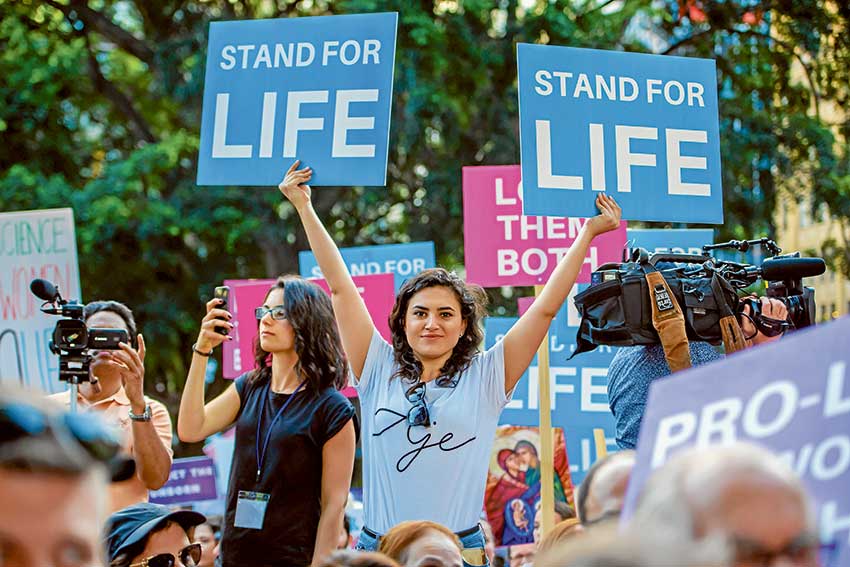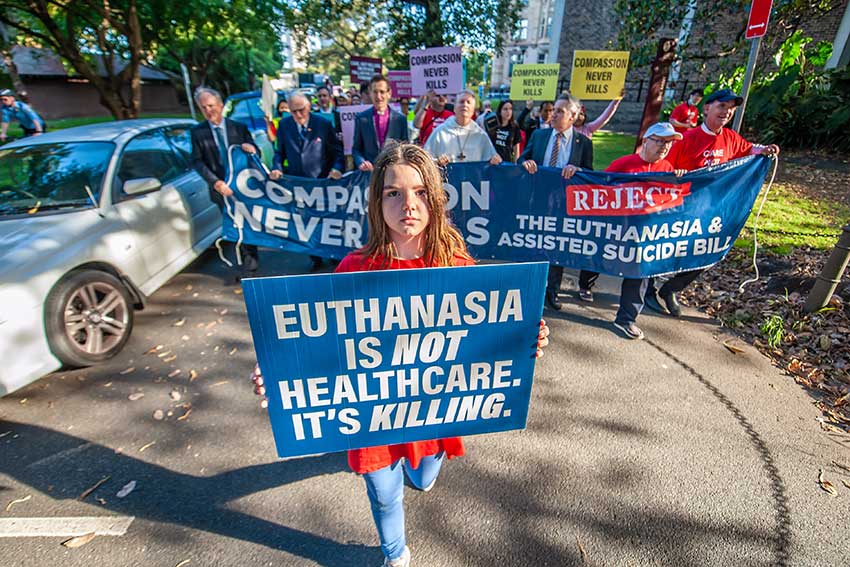
The NSW Government’s bill on so-called conversion therapy has finally been introduced. Delayed debates over whether a person should be able to self-identify their sex on official documents, or engage in commercial surrogacy, or solicit for prostitution outside churches and schools will probably take place, at last, in May.
There will also be movement on religious exemptions to state-based anti-discrimination laws and a push to allow kids to consent to medical treatment, even gender transition, against the will of their parents.
In federal parliament this week, a report from the Australian Law Reform Commission will almost certainly recommend either removing or severely restricting all existing religious freedom protections for faith-based schools.
On top of this, a bill that will allow doctors to approve requests for euthanasia over the phone is soon to be considered, as will the results of the recent Productivity Commission inquiry that proposed limitations on the charitable benefits to religious bodies.
And last week, Senator Katy Gallagher, the Minister for Women and one of Prime Minister Anthony Albanese’s “inner circle,” appeared to indicate a revival of Labor’s 2019 policy that would force public hospitals to provide abortions.
These are just the issues that lie ahead of us in the coming weeks and months, but since 2017’s legalisation of same-sex marriage, Catholics have seen the full decriminalisation of abortion, gag laws that prevent even silent prayer within 150 metres of an abortion clinic, euthanasia on demand, increased public funding for IVF, a conversion therapy ban in Victoria that explicitly prohibits “prayer-based practices,” a stripping away of protections for the seal of confession and more.
Seven years of relentless undermining of the Catholic witness in Australia is not just a “perfect storm,” a chance correlation between unrelated laws and policies. Rather each challenge to Australia’s culture of life is an attempt to remove, or reduce the freedom of, the family, church and other faith-based organisations as “mediating institutions.”
Mediating institutions are those intermediary structures that stand between the power and authority of the state and the individual citizen. Mediation is at the heart of the Catholic worldview, with Christ as the anointed mediator of the new covenant (Heb 9:15) to reconcile fallen humankind with the Father. We have a visible church, with sacraments that mediate grace to us, and a priesthood to administer them.
This principle of mediation also affects our approach to political life in profound ways. As St John Paul II wrote in his 1991 encyclical, Centesimus Annus, “the social nature of man is not completely fulfilled in the State, but is realised in various intermediary groups, beginning with the family and including economic, social, political and cultural groups which stem from human nature itself and have their own autonomy, always with a view to the common good.”
The rejection of this vision of the human person, the saintly pope explains, stems from an atheistic worldview because it seeks to create a social order without reference to a person’s dignity or responsibility. It presumes that the good of an individual can be attained without giving them free choice—a socialist mindset.
It also denies the need for mediation—what Catholic social teaching describes using the term “subsidiarity”—and seeks to expose the individual to the naked, impersonal, immediate power of the State. This increases freedom, but only for the government; for the individual, mediation increases freedom, self-expression and flourishing. Hence why the oldest and most important mediating institutions in western society are the Catholic Church and the family unit.
By the church I mean not only our places of worship and formal ecclesial structures, but our broader institutional footprint, which includes schools and universities, hospitals and aged care facilities, charitable bodies and social welfare agencies. Indeed, the Catholic Church is the largest mediating institution in the world.
While “family” can be defined broadly, the nuclear family is the first, smallest and most personal of the mediating institutions. The catechism rightly teaches that it is the “basic unit of the social fabric of society itself.” The family is where most people learn how to be themselves, how to love and care for others, how to be responsible—formal schooling develops what is learned primarily from mum and dad.
So if you want to increase the power and capacity of the state to act without opposition, you attack the family and you attack the church. And when we consider the sweeping changes made since the same-sex marriage plebiscite, and what is yet to come, we should ask: Does this proposed law or policy limit or undermine the freedom of the church or the family to act as a mediating institution and if so, in what way?

Consider last year’s compulsory acquisition of Calvary Hospital by the ACT Government. One month prior to the announced takeover, a report from the same government criticised its restriction of services because of its “overriding religious ethos.” The quickest and most brazen way to remove or limit the freedom of a mediating institution is to compulsorily acquire it. In this case, the state not only took over the property and operations, but also the staff—other than those who felt so morally connected to Calvary’s Catholic ethos that they preferred to resign. This was a double “win” for the state, because it meant many of the conscientiously Catholic staff were weeded out in a seemingly neutral process.
Another way to limit the freedom of mediating institutions is to remove their ability to employ staff who share their ethos. This strategy is at work in the Australian Law Reform Commission inquiry and report which, as I wrote above, is expected to be released in the next few days.
Last year’s consultation paper from the ALRC proposed such dramatic changes to employment and teaching that it would have made religious schools almost indistinguishable from state schools.
For example, one proposal was that faith-based schools would no longer be able to preference teachers of the same faith for employment unless they were for senior leadership roles, or to teach religious education. And while a school could require a religious education teacher to teach religious doctrine, the school could not prevent them from teaching “alternate” views.
On the one hand, the law leaves people “free” to come together to form religious schools but then imposes burdensome restrictions on who a school can hire and what staff can be required to teach. These types of restrictions are not as brazen as a Calvary takeover, but still do their bit to minimise the integrity of a mediating institution to offer an alternative vision of life, by gutting it of its religious character. You can have a religious school, but not a critical mass of religious staff; you can have religious education, but not authentic religious teaching and so on.
Another way to restrict the freedom of mediating institutions is to remove their funding, or at least to make funding arrangements contingent on engaging in practices contrary to your religious ethos. Speaking recently to the National Press Club, Senator Katy Gallagher foreshadowed that Labor might seek to tie funding of public hospitals to abortion provision.
One can imagine that, down the track, such a policy might be extended to other interventions as well: euthanasia, IVF, gender transition and more.
There was also the recent draft report from the Productivity Commission, reported in last week’s Catholic Weekly, that proposed things like removing tax-deductible status from school building funds and offering tax-deductibility to a broad range of charitable causes, except those linked with the advancement of religion.
Removing government funding from, or incentives for everyday Australians to donate to, religious charities is another way of limiting the freedom and influence of mediating institutions and preferencing the state. After all, the church can’t levy taxes to fund its charitable operations and services—many of which are preferred by Australians to those run by the government.
All of these have to do with the church and its ministries, but what about the family? Don’t proposed laws allowing commercial surrogacy undermine the mediating institution of the family by making bringing a child into the world a contractual, rather than covenantal, relationship? Don’t laws that circumvent parental consent to medical treatment for children directly attack the relationship between parent and child?
The more widespread euthanasia becomes, do we not forget intergenerational responsibility amongst family members? Freedom and dignity in old age are secured, in part, by younger generations caring for their elders in return for their sacrifices, and in the knowledge that they will also receive the same care.
Even policies around free childcare and the push for gender equality in senior leadership positions send a message that the best thing for society is mothers returning to work as quickly as possible after giving birth to children—even where the mothers themselves would rather stay home with their babies.
All of the above, couched in the language of “autonomy,” “equality” and “freedom”—or diversity, equity and inclusion—actually serves to restrict freedom. Individuals need mediating institutions to be free, to have the chance to grow and flourish, because the state cannot provide everything a person needs to live, and certainly cannot provide the conditions for the worship of God. Yet the tendency since 2017 is to degrade the capacity of the church and family, while making us more reliant on the state.
Far from being a niche issue for lawyers and advocates, the religious freedom cause is a fight to secure those institutions that form the very foundations of our society. While each individual bill and policy must be assessed on its merits, Catholics must note the trend—and be prepared to make their voices heard at the ballot box when the time comes.
